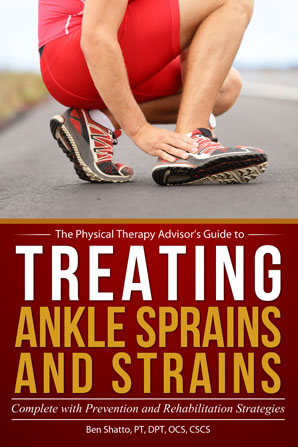Ankle sprains are the most common orthopaedic injury and can happen to anyone at any age. In general, an ankle sprain occurs when you twist your ankle too far. It causes the ligaments (which support the ankle) to get stretched and/or torn. Depending on the severity and the ligament damaged, a sprain may take from several weeks to months to fully heal. The more pain, swelling, and bruising you experience initially often indicates the severity of the injury (possibly indicating a longer recovery).

An ankle sprain is such a common occurrence that it’s often marginalized as an injury. Most people simply take it easy for a while until the pain of the sprain decreases to point that normal activities can be resumed. What many people do not realize is that a poorly rehabilitated sprained ankle can lead to long term debility. It can be even be associated with pain and debility elsewhere as the body is forced to compensate for a poorly functioning ankle.
One of the most common issues following an ankle sprain is the lack of dorsiflexion (the ability to move the ankle up toward the shinbone). This loss of ankle mobility forces a person to alter his/her gait pattern to compensate for the lack of mobility by taking shorter steps or rotating his/her leg or foot externally (outward). Over time, this causes additional stress and potentially pain and/or injury in the arch of the foot, knee, and hip.
As a physical therapist, I have treated many people who have experienced a past ankle sprain which led to poor ankle mobility. Now they are experiencing a myriad of orthopaedic issues simply from a past ankle sprain.
In addition, a chronically sprained or severely sprained ankle that isn’t properly treated could present with ligament deficiencies. This means that one or more of the ligaments in the ankle were completely torn or significantly overstretched. An unstable ankle that is not rehabilitated appropriately tends to force individuals into self-regulating activities. Some slowly become more sedentary either due to ongoing pain or the fear of falling. In a well rehabilitated ankle, one can learn to compensate by utilizing muscle strength and motor control in order to manage pain and discomfort while maintaining mobility. In some cases, surgical intervention will be required to repair the torn ligaments.
The importance of proper treatment and rehabilitation after even a minor ankle sprain cannot be overstated! The key is to insure that you completely recover from the injury. Otherwise, you’re at risk for repeated injury when you don’t complete the necessary course of rehabilitation. Once you have experienced an ankle sprain, you are more likely to experience another one if you don’t properly rehabilitate your ankle and address any precipitating factors that may increase your risk of repeated injury.
Knowing how to effectively self-treat and manage ankle sprains and strains is important in order to resume your training and normal activities without the risk of additional damage, injury or re-injury. When you can confidently self-treat, you can limit pain levels, return to activity faster, and prevent reoccurrences.

AVAILABLE NOW ON AMAZON!
In my book, Treating Ankle Sprains and Strains, you will learn how to safely and confidently self-rehabilitate a common ankle sprain. It will guide you through the ins and outs of self-treating your ankle so you can avoid costly rehabilitation bills. Beginning with the acute phase of rehabilitation, I will walk you through the treatment plan on how to rehabilitate your ankle through the intermediate (sub-acute) phase of rehabilitation and return to full activity and sport.
Learn how to safely self-treat and properly rehabilitate your ankle so you can get back to your daily life and exercise goals more quickly without additional costly medical bills!
